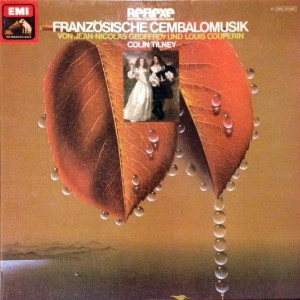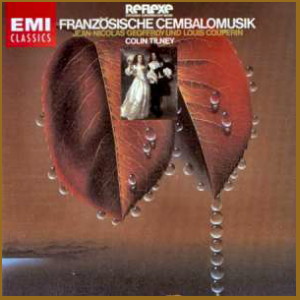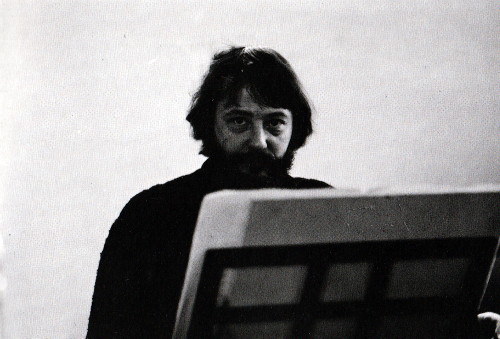 |
1 LP -
1C 065-30 946 - (p) 1978
|

|
| 1 CD - 8
26514 2 - (c) 2000 |
 |
| 1 CD -
CDM 7 63425 2 - (c) 1990 |
|
| FRANZÖSISCHE CEMBALOMUSIK |
|
|
|
|
|
| Jean-Nicolas
Geoffroy (?-ende des 17. Jh.) |
|
|
| Suite en la
mineur |
|
|
| - Allemande |
4' 04" |
|
| - Courante |
1' 32" |
|
| -
Sarabande |
2' 36" |
|
| -
Gigue |
2'
27"
|
|
| - Chaconne |
4' 09" |
|
| Louis Couperin (um 1626-1661) |
|
|
| Suite
en fa majeur |
|
|
| -
Prélude |
1' 58" |
|
| -
Allemande grave |
3' 28" |
|
| -
Courante |
1' 08" |
|
| -
Sarabande |
2' 15" |
|
| -
Chaconne |
2' 46" |
|
|
|
|
| - Tombeau de
Monsieur de Blancrocher |
4' 11" |
|
| - Gigue |
1' 46" |
|
| -
Chaconne |
3' 45" |
|
| Jean-Nicolas
Geoffroy (?-ende des 17. Jh.) |
|
|
| Suite
en ut mineur |
|
|
| -
Allemande la Confidente |
2' 19" |
|
| -
Tombeau en forme d'allemande |
4' 34" |
|
| -
Courante |
1' 36" |
|
| -
Sarabande |
2' 12" |
|
| -
Gigue |
2' 06" |
|
| -
Chaconne |
2' 47" |
|
|
|
|
Colin Tilney, Cembalo
(Vincent Tibaut, Toulouse 1681, aus dem
Besitz von Yannick Guillou. Intonierung
Johannes Carda)
|
|
|
|
|
|
Luogo
e data di registrazione |
|
6 Rue de
Solférino, Paris (Francia) - 6-9
dicembre 1977 |
|
|
Registrazione: live /
studio |
|
studio |
|
|
Producer / Engineer |
|
Gerd
Berg / Johann-Nikolaus Matthes
|
|
|
Prima Edizione LP |
|
EMI
Electrola "Reflexe" - 1C 065-30
945 - (1 lp) - durata 51' 47" -
(p) 1978 - Analogico |
|
|
Prima Edizione CD |
|
EMI
"Classics" - CDM 7 63425 2 - (1
cd) - durata 51' 47" - (c) 1990 -
ADD |
|
|
Edizione CD |
|
EMI
"Classics" - 8 26514 2 - (1 cd) -
durata 51' 47" - (c) 2000 - ADD |
|
|
Note |
|
- |
|
|
|
|
|
 FRENCH
HARPSICHOR MUSIC FRENCH
HARPSICHOR MUSIC
Those
for whom seventeenth-century
music says something
distinctive and necessary have
long been familiar with the
voice of Louis Couperin. His
preludes, dance movements and
occasional pieces belong to
that special store of keyboard
music that succeeds well
before an audience, but gives
even greater pleasure to the
player in private. Couperin’s
life is adequately charted,
and there have been three
modern editions of his work;
all in all, he stands in the
public domain. The same does
not hold good for Jean Nicolas
Geoffroy, a name that will be
completely unknown to most
listeners, although his music
is as original, passionate and
uncompromising as that of
Louis Couperin, sometimes
perhaps even more so. Organist
of the Paris church of St.
Nicolas-du-Chardonnet,
Geoffroy moved in 1690 to
Perpignan, near the Spanish
Mediterranean border, where he
held the post of cathedral
organist until his death four
years later. His work - or
some of it, at least - is
preserved in a rather
mysterious small manuscript in
the Paris Bibliotheque
Nationale. No modern edition
exists as yet. This seems to
be the first recording of any
of Geoffroy’s harpsichord
music, certainly the first to
be played on a French
seventeenth-century
instrument. Apart from the
facts given above we know very
little about Geoffroy’s life.
We are not even sure which of
several musicians called
Geoffroy the composer was: the
name was a common one in Paris
at the end of the seventeenth
century. Martine Roche, the
only person to have made a
detailed survey* of Bibliothèque
Nationale Rés.
475, has researched the
question with great
thoroughness but found no
satisfactory answer, just as
she has been unable to
establish the date of the
manuscript or the identity of
the copyist. The volume is
certainly not autograph, since
it is described as follows in
a note inside the front cover:
“Livre des pieces de clavessin
de tous les Tons Naturels et
transposéz,
de Jean Nicolas Geoffroy
Organiste de St. Nicolas du
Chardonnet a Paris
et depuis Organiste de la
cathedralle St. Jean de Perpignan
En Catalogne ou Il est
mort". Martine Roche dates the
manuscript between the
publications of D`Anglebert
(1689) and Le Roux (1705), but
this is surely too late;
between 1665 and 1680 seems
more likely. No music by
Geoffroy is included in the
important Bauyn MS (about
1660), the main source for
Louis Couperin. The 255 pieces
of Rés.
475 comprise 14 suites,
arranged by key stepwise from
C minor to B minor, four
immense chaconnes, some
separate descriptive pieces
and two dialogues for organ
and three viols. There are no
preludes. Four of the suites,
in the remoter keys of E
major, F minor, A major and B
minor, reappear in F major, G
minor, G major and A minor,
with modifications and
enrichments, showing that the
meantone tuning so hotly
defended by Jean Denis in his
Traité
de l'accord
de l’éspinette of 1643
may have suited the public
better than it did the
composers. Certainly Louis
Couperin wrote in some of the
"difficult"
keys that Geoffroy uses and
added one more - F sharp minor
- that definitely must be
differently tempered to be
endurable. However, Geoffroy
(or whoever did the
transcriptions) offers C
minor, with its prominent A
flat, without change or
comment. One curious feature
of Rés.
475 is that 122 pieces, none
of them recorded here, are
written throughout in two
parts, an economy that shows
Geoffroy’s angular harmonic
thinking to good advantage. A
final puzzle is the note “Tirée des
pieces de son Opera de
clavessin” attached to some of
the numbers; it seems to imply
that the manuscript is merely
a selection from some larger
printed source, although no
such publication has yet been
traced. The words “a la
maitrise de R..." (a now
illegible name of five
letters) can just be made out
inside the cover. Did Rés. 475
one belong to the cathedral
library of some such place as
Rouen or Reims? A companion
volume having the same
provenance, Rés.
476, an anonymous collection
of seventeenth-century French
organ music, has been
published under the name of
Geoffroy in a modern edition
on the strength of a common
background to the two books,
but the identification is not
supported either by
handwriting or by musical
style.
In
Geoffroy‘s suites, the
traditional movements of
allemande, courante and
sarabande occur in that order,
with the smaller two-voice
dances (gavottes, menuets,
rondeaux etc.) inserted
between sarabande and gigue. A
chaconne or passacaille nearly
always seems to close the
work, but the manuscript is so
crowded, spacesaving and full
of directs that we cannot
always be sure of the author’s
intentions - or even of the
copyist’s. A notational oddity
of the F minor suite is the
key-signature of two flats - B
flat and A flat! All D‘s and
E’s are assumed natural,
unless specifically flattened
before the note, but the rule
is so cavalierly applied that
the alternative G minor
version proves a godsend,
especially in the nearly
unbelievable (but doubly
verifiable) final couplet
of the chaconne. From the
first few bars of this F minor
suite we are confronted by
music of an arresting
personality: a melodic rise
and fall of great gravity and
poise, underscored by tense,
athletic harmonies, a fondness
for contrary motion, false
relations and for sharp
dissonances of the seventh and
ninth,wide chordal spacing,
egocentric middle voices that
recall Purcell’s viola lines,
obsessive rhythmic patterns
throughout a whole movement
(the first allemande and the
gigue from the C minor suite,
for instance) and, most
striking of all, the ability
to compress a world of meaning
into half a reprise, even into
half a bar. Both the
sarabandes are memorable, as
is the unobtrusive skill with
which Geoffroy builds the
entire F minor gigue on a
three-bar unit, but the
composer’s greatest
achievement is probably the
second C minor allemande. The
eloquence of the upper voice
and the chromatic intensity of
the harmonies, sometimes
sounded together, sometimes
broken in stile luthé,
set this lament on the same
level as the more famous
tributes of the French lutenists
and violistes,
and of Froberger, Louis
Couperin and D’Anglebert among
the harpsichordists. Was it
perhaps indeed intended for
the unhappy lutenist,
Blancrocher, whose drunken
fall downstairs was
commemorated by both Froberger
and Couperin? A point in
common with the other two tombeaux
is the peal of bells heard
briefly in the second half and
actually marked “Carillon” in
Geoffroy’s allemande.
Neither Geoffroy's music nor
Louis Couperin’s remotely
resembles the delicate art of
Chambonnières,
the author of the first
published books of harpsichord
music in France (1670) and
Couperin’s teacher (or at
least patron) in Paris from
the early 1650's onwards.
Possibly Chambonnières’
influence on Couperin was more
social than musical, for a
contemporary wrote that the
two men were like “deux chefs
de secte”, both excelling in
their art, but in character
totally dissimilar: one was
said to touch the ear, the
other the heart. Le Gallois’
judgment is perhaps a little
unjust to Chambonnières,
whose restraint and subtlety
can often be very moving, but
undoubtedly Louis Couperin’s
serene sensuality appeals very
immediately to modern ears.
The second F major chaconne is
marked “de Monsieur Chambonnières"
in the Bauyn MS, but only an
excessive reliance on eye
rather than ear could
perpetuate the attribution:
melodic contour, harmonic
richness and tessitura all
suggest Couperin as the
author. The two most enigmatic
pieces in this arbitrarily
chosen ‘suite’ are the ones
that most nearly approach
extempore improvisation: the
lament for Blancrocher and the
unmeasured prelude. Louis
Couperin’s gently-tolling F,
G, F, G seems a kinder
farewell than Froberger’s lugubrious
descending scale (or than
Geoffroy’s exuberant outburst,
if that indeed records the
same occasion); maybe we can
detect affection in this music
as well as piety. The
prelude,too, has a connection
with the Parisian luteworld.
Before a concert lutenists
used to announce the key of
the following pieces, warm up
their fingers and test the
tuning of their strings by
playing a short, rhythmically
free introduction. In adopting
this practice, the clavecinistes
had the idea of using
whole-note notation without
bar-lines to suggest the
indefinite duration of lute
sound, but they linked the
harmonic progressions together
with a maze of sweeping lines
and curves. Couperin,
characteristically, breaks
into a little Italianate
jig, written out quite
precisely, before sinking to
rest on a slightly
sanctimonious plagal cadence.
Colin
Tilney, 1978
* Martine
Roche: Un livre de
clavecin de la
fin du XVIIe siécle
(Recherches sur la musique
française
classique, VII, 1967)
|
|
|
EMI Electrola
"Reflexe"
|
|
|
|

